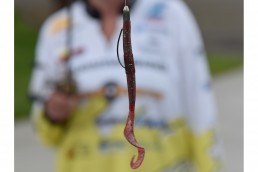Today’s Texas Rigs Offer More Options
SHARE THIS POST
Author Scott Petersen uses Texas Rigs to catch bass in a variety of conditions.
When targeting bass, I have taken a step back in the last few years and have been depending more on throwing a simple Texas Rig again. This newfound, old-reliable Texas Rig use started one day when I was cleaning the garage and came across a bag of assorted 6-inch worms that I had misplaced, so back in the boat they went.
My next time on the water, I was sharing the boat with a very good friend. Knowing I had that bag of 6-inch worms, I grabbed my Texas Rig rod, rigged up a worm and started fishing. By the end of the day, I caught more bass than my boat partner, with the biggest bass of the day pushing 5 1/2 pounds. So, let’s take a look at the power of today’s Texas Rig.
The worm craze started back in 1949 when Nick Creme came up with the first worm. This worm had hooks threaded into the worm body, connected by line in between them. But, it was a fisherman from Tyler Lake, Texas ten years later that figured out the first Texas-rigged worm. Getting tired of his plastic worm getting caught in/on the cover, he rigged a worm that had the hook point buried into the worm.
Many years ago, the Texas Rig was king—at least for a while. Rubber-legged jigs were just starting to make their first impact on the bass fishing scene. In those days, many of the jigs were made of deer hair, but rubber jigs were just starting to break onto the scene and were fast becoming the hot new popular technique. After a while, jigs started to become even more popular, and it was not uncommon for bass fishermen to carry a good assortment of both jigs and worms in their boats.
Through the years, there have been changes to the Texas Rig. The biggest change has been that there are more than just worms in today’s Texas lineup. There are tubes, craws, lizards, creature baits—and these are just scratching the surface. Try all that you can when it comes to new baits. You may just find a bait that works better in your waters that no one else is using yet.
Are you enjoying this post?
You can be among the first to get the latest info on where to go, what to use and how to use it!
When you take a closer look at Texas Rig fishing, it is all fueled by feel. You must be able to feel what your bait is doing and how it is acting—especially when the fish bite and it’s time to set the hook. Today’s graphite materials being used are light years ahead of how rods used to be manufactured.
Line options nowadays have done a lot to fuel the Texas Rigs’ fishing growth as well. Today’s monofilament line is better, and when you add fluorocarbon and braided line options to this mix, you have sensitivity that is over 100 percent better than what it used to be.
I feel that one of the biggest improvements that has pushed Texas Rig fishing to today’s level was the introduction of tungsten sinkers. When more and more bass fishermen started to embrace and use tungsten sinkers, there was more feel to what your Texas Rig was doing than ever before.
Want some more great fishing information? Read the May issue of MidWest Outdoors, available the first full week of May at the newsstand or by subscribing on our website.
MWO
SHARE THIS POST
You may also like...
Nothing found.
Did you enjoy this post?
You can be among the first to get the latest info on where to go, what to use and how to use it!
Scott Petersen
Scott Petersen has been writing for the past 30 years. A Minnesota native, he has a passion to fish all seasons on ice and open water. “One of my main goals is to teach people how to fish through my articles and sport-show seminars.”
